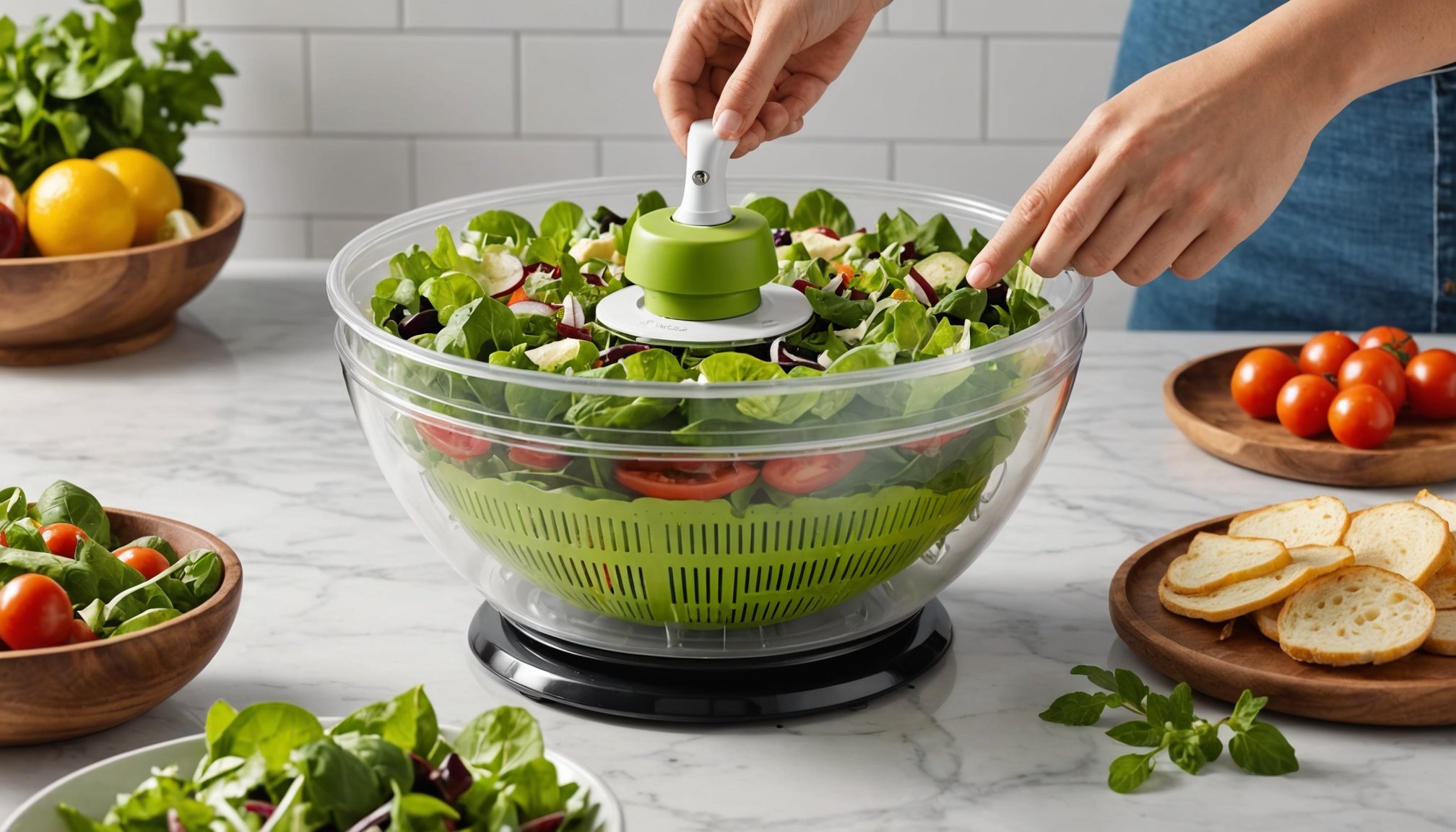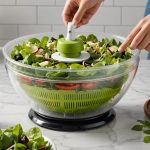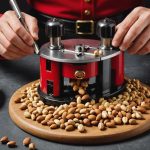Salads can be a delightful addition to any meal, but have you ever considered how a well-designed salad spinner affects freshness? Essential design elements are key to maximizing taste and texture. Understanding features like basket construction, spinning mechanisms, and drainage systems can enhance both your salad experience and food preservation. Unlock the secrets to choosing an effective salad spinner that elevates your creations while ensuring ingredients stay crisp and vibrant. Discover how the right tools can transform your salad enjoyment!
Key Design Mechanisms of Salad Spinners
Understanding the salad spinner mechanism is crucial for effective salad preparation. At its core, the mechanism leverages centrifugal force to remove excess water. When you spin the salad, the force pushes water outwards, away from the center, effectively drying the leaves. This process is not only efficient but also preserves the freshness and texture of the salad.
In parallel : Discover the Best Anti-Fatigue Flooring Options for Comfortable Cooking in a Compact Kitchen
Centrifugal Force in Action
The magic behind drying salad lies in centrifugal force. This force is generated when the spinner is rotated, causing water droplets to be flung off the leaves and collected in the outer bowl. This ensures your salad is crisp and ready to serve.
Spinning Mechanisms: Manual vs. Electric
Salad spinners come with different spinning mechanisms. Manual spinners often use a pull-cord or crank handle, allowing users to control the speed. In contrast, electric spinners offer automated convenience with consistent results. Here's a quick comparison:
Also to see : Essential Features of a Slimming Microwave: Your Guide to Healthier Meal Prep!
-
Manual Spinners
-
More control over speed
-
No electricity needed
-
Generally more affordable
-
Electric Spinners
-
Faster and less effort
-
Consistent drying process
-
Typically higher cost
Both types have their pros and cons, but the choice depends on personal preference and kitchen needs. With the right salad spinner mechanism, you can enjoy a perfectly dried salad every time.
Material Considerations in Salad Spinner Design
Understanding the materials used in salad spinner design is vital for ensuring both durability and food safety.
Common Materials and Their Benefits
Plastic is the most prevalent material. It's lightweight and often more affordable. However, when choosing plastic, ensure it's BPA-free to avoid potential health risks. Stainless steel offers a more robust and durable option, often preferred for its longevity and resistance to rust. Glass provides an elegant appearance but is heavier and more fragile.
Food Safety and Durability
The importance of using BPA-free materials cannot be overstated. BPA, a chemical found in some plastics, can leach into food, posing health risks. Opting for BPA-free ensures that your salad remains safe to consume. Additionally, the choice of material directly impacts the longevity of your salad spinner. Stainless steel is less prone to wear and tear, whereas plastic may degrade faster over time.
Material Impact on Longevity
- Plastic: Lightweight, affordable, but less durable.
- Stainless Steel: Durable and rust-resistant, ideal for long-term use.
- Glass: Elegant but fragile, less practical for frequent use.
Selecting the right material for your salad spinner is crucial for balancing safety, durability, and functionality.
Size and Capacity of Salad Spinners
Understanding the right size and capacity for your needs can enhance salad preparation.
Various Sizes and Their Uses
When choosing a salad spinner, size and capacity options play a crucial role. Salad spinners typically range from compact models suitable for single servings to larger ones designed for family-sized portions. A smaller spinner is ideal for individuals or couples, while a larger capacity is beneficial for those preparing salads for multiple people.
Importance of Capacity in Salad Preparation
Capacity directly impacts how effectively you can prepare and serve your salad. A spinner with insufficient capacity might require multiple rounds, leading to inefficiency. Conversely, a spinner that's too large may be cumbersome for smaller batches. Thus, matching the spinner's size and capacity to your serving size can streamline your kitchen routine.
Recommendations for Different Users
Consider these recommendations based on user needs:
- Single Users: Opt for a spinner with a capacity of 2-3 quarts.
- Families: Choose a larger spinner, around 4-6 quarts, to accommodate more servings.
- Entertaining: Larger spinners with capacities over 6 quarts are ideal for gatherings.
Choosing the right salad spinner size and capacity ensures efficient and enjoyable meal preparation.
User-Friendly Features in Salad Spinners
Enhancing comfort and ease of use in salad preparation.
Ergonomic Design for Comfort
The ergonomic design of salad spinners plays a crucial role in enhancing user comfort. Features such as comfortable handles and well-balanced bases ensure that users can operate the spinner without strain. Many models incorporate soft-grip handles, which reduce hand fatigue during use, making the process smoother and more enjoyable.
Easy-to-Use Mechanisms
Ease of use is paramount in salad spinner functionality. Locking lids prevent accidental spills, ensuring a mess-free experience. Additionally, intuitive mechanisms such as push-button or crank handles simplify the spinning process. These features make salad preparation not only efficient but also enjoyable.
Impact of Design on Usability
User testimonials often highlight the significance of design on usability. Many users appreciate salad spinners with ergonomic design for their ability to make everyday tasks more manageable. As one user noted, "The comfortable handles and easy-to-use mechanisms transform salad preparation into a quick and pleasant task."
Features to Consider:
- Comfortable Handles: Reduce strain during use.
- Locking Lids: Ensure safety and prevent spills.
- Ergonomic Design: Enhances overall user experience.
Selecting a salad spinner with these user-friendly features can greatly improve kitchen efficiency and comfort.
Enhancements for Salad Freshness
Ensuring your salad remains fresh after preparation is essential for both taste and texture.
Techniques for Moisture Removal
Maximizing moisture removal during the spinning process is key to preserving salad freshness. To optimize this, ensure the salad spinner is not overloaded. This allows leaves to move freely, enhancing the centrifugal action that removes excess water. A well-spun salad not only stays crisp but also absorbs dressings better.
Storing Salads for Longer Freshness
Once the moisture is effectively removed, using the salad spinner as a storage tool can extend freshness. Place a paper towel in the bottom of the spinner bowl to absorb any residual moisture. This simple technique keeps leaves dry and fresh for longer periods. Remember to keep the lid tightly sealed to maintain an optimal environment for freshness preservation.
Lid Features for Freshness
Lid features play a significant role in maintaining salad freshness. Some spinners come with airtight lids that prevent external moisture from entering, keeping the contents dry. Additionally, lids with adjustable vents allow for controlled air circulation, further aiding in freshness preservation.
Key Points to Consider:
- Moisture Removal: Essential for crispness.
- Storage Tips: Use paper towels for moisture absorption.
- Lid Features: Airtight and vented lids enhance freshness.
Comparisons of Top Salad Spinner Models
Exploring the best options to enhance your salad preparation experience.
Overview of Leading Models
Choosing the right salad spinner can transform your kitchen routine. Among the top models, the OXO Good Grips, Cuisinart CTG-00-SAS, and Gourmia GSA9240 stand out. Each offers unique features, catering to different preferences and needs.
Feature and Price Comparison
Here's a comparison of these leading salad spinner models:
| Model | Features | Price Range |
|---|---|---|
| OXO Good Grips | Ergonomic design, non-slip base | $30-$40 |
| Cuisinart CTG-00-SAS | BPA-free, easy crank handle | $20-$30 |
| Gourmia GSA9240 | Electric, consistent performance | $40-$50 |
User Ratings and Recommendations
User feedback is essential when comparing salad spinner reviews. The OXO Good Grips is praised for its durability and ease of use, while the Cuisinart model is favored for its affordability and simplicity. The Gourmia model, though pricier, is recommended for those who prefer electric spinners.
Recommendations:
- Budget-Friendly: Cuisinart CTG-00-SAS
- Best Overall: OXO Good Grips
- For Convenience: Gourmia GSA9240
Selecting the right salad spinner involves considering both features and price points to meet your specific needs.
Tips for Maintaining Salad Quality
Enhancing the freshness and taste of your salad.
Best Practices for Washing and Preparing Greens
Proper salad preparation starts with washing greens thoroughly to remove any dirt or pesticides. Use cold water and a gentle rinse to maintain the leaves' crispness. After washing, dry the greens well using a salad spinner to maximize moisture removal. This step is crucial for maintaining salad quality, as excess water can lead to sogginess.
Importance of Proper Storage Techniques
Once prepared, storing your salad correctly is essential. Transfer the dried greens to an airtight container and refrigerate. Adding a paper towel can absorb any remaining moisture, preserving freshness. Proper storage methods ensure your salad stays crisp and ready to enjoy.
Suggestions for Combining Ingredients
Combining the right ingredients can significantly enhance your salad experience. Consider pairing leafy greens with a variety of textures and flavors, such as nuts, fruits, and cheeses. This not only improves the taste but also maintains the salad quality by offering a balanced and enjoyable meal.
Key Tips:
- Wash greens in cold water
- Dry thoroughly with a salad spinner
- Store in airtight containers with a paper towel
Implementing these tips will help ensure your salads remain fresh, tasty, and enjoyable.
Visual Aids and Infographics
Enhancing understanding of salad spinner features through visual tools.
Benefits of Using Infographics
Infographics are powerful tools for illustrating the complex features of a salad spinner. They simplify information, making it more accessible and engaging. By breaking down the mechanics into visuals, users can quickly grasp how to operate their spinners effectively. This not only aids in better comprehension but also enhances the overall user experience.
Examples of Effective Visual Guides
Effective visual guides for salad preparation can transform how users interact with their kitchen tools. For instance, diagrams showing the centrifugal force in action can clarify how excess water is removed. Step-by-step illustrations of both manual and electric spinners can also provide clarity on their operation.
Visual Guide Components:
- Step-by-step diagrams
- Centrifugal force illustrations
- Comparison charts
Resources for Instructional Videos
For those seeking further understanding, a variety of educational resources are available. Instructional videos often accompany infographics, offering dynamic demonstrations of salad preparation techniques. These resources provide a comprehensive look at maximizing the efficiency and functionality of your salad spinner. By utilizing these visual aids, users can enhance their salad preparation skills and ensure optimal results.













